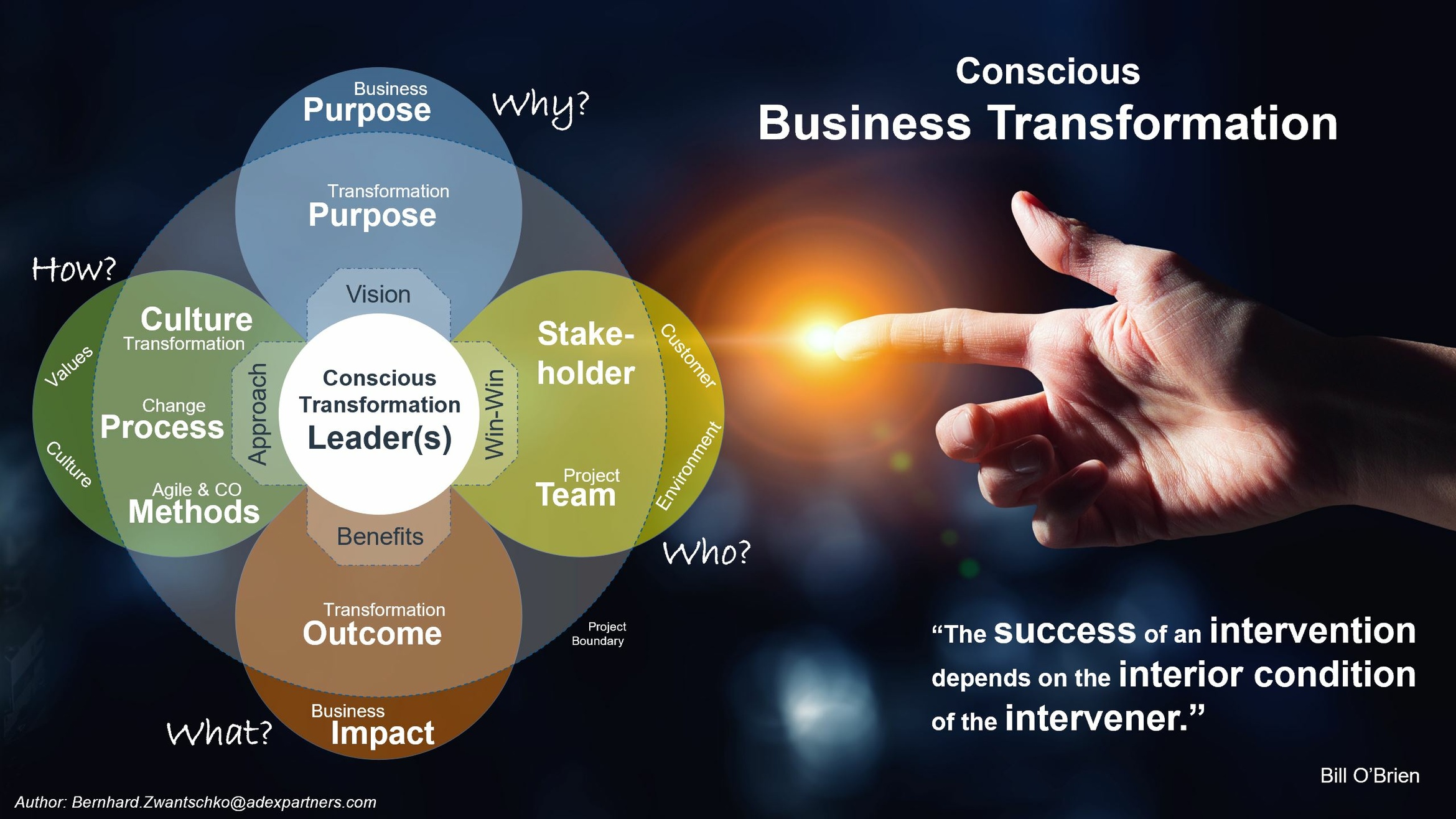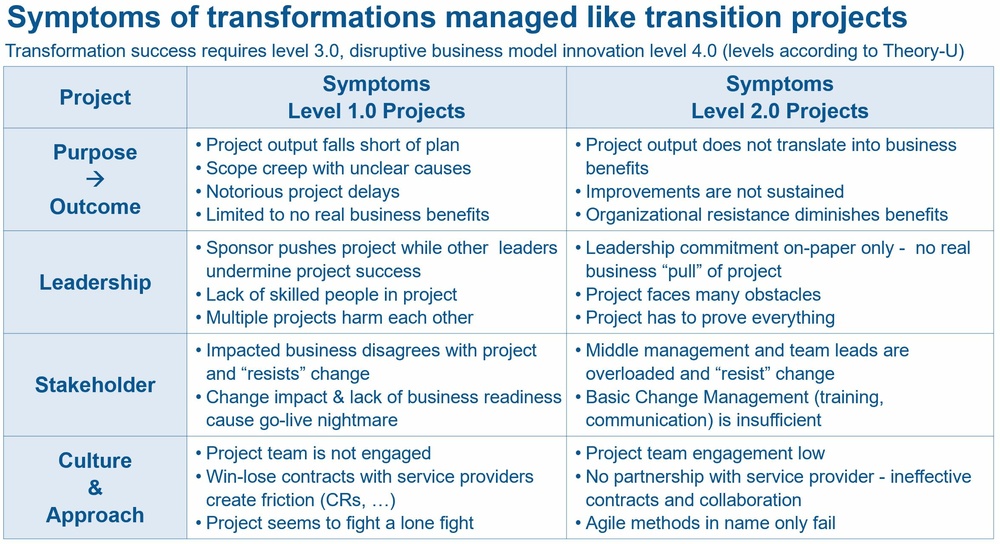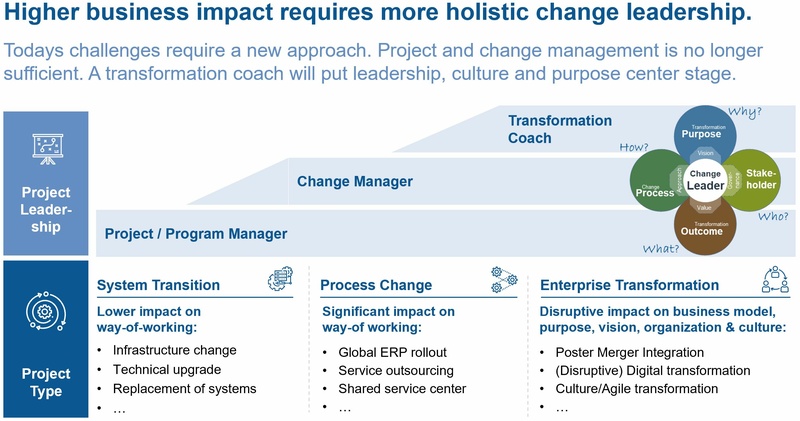Transformation failure decoded … The blind spot is Leadership attention!
Many companies use transformation as a buzz word for change. And countless businesses undertake some type of transformation right now. Unfortunately, most will fail. It does not have to be that way.
Companies now call their bigger projects “transformation” – but most are still executed and fail like projects in the last century. Sadly, not much has changed. Still projects are delivered mechanically with a focus on the visible output only. And while few apply some form of “change management” most use the phrase only to overcome the “resistance” of stakeholders.
The main deciding factor for transformation success or failure is not even on the radar – the blind spot of transformations: Conscious Change Leaders Steering with Purpose.


Transformation Failure
It’s all just about delivering a defined scope in time and on budget, isn’t it? The short answer: a resounding no. Classic project management with a focus on the “What” predictively struggles to create value, but in a dynamic and agile market environment with new demands from customers and millennials alike, these approaches do not work at all anymore.
Have you recently sat in a Project Steering Committee with hours-long technical reports, (exhausting death-by-PowerPoint) slide decks, and decisions to be made, with little to no context, while the real conversations did not happen? Or see the scope and complexity of the project increase in an environment void of value only to later have experienced business, IT and external consultants blame each other for the project’s failure?
You may be thinking: Projects have always been this way and they always will – Right? – I dare to disagree. This is not my experience.
In a recent transformation-coaching assignment for a project which was already going on for multiple years (around 200 consultants and client project members) everyone was working in a split world – a client/contractor divide – a complete divide between the ones that need to deliver and the ones that make demands. Something as basic as a common project organization chart did not exist. As a first intervention, both parties were asked to write down their short- and long-term goals for the project. When we then compared them side to side – they were almost identical. The question was in the room: So why do we not work TOGETHER on these goals? A new “purpose driven” conscious awakening of both leadership teams whirled the project around and had a huge positive impact down the hierarchy. This led to a new written contract to better balance responsibility and accountability, and a fruitful collaboration on all levels. Of course, there were several other items we addressed, but it was confirmed by all that the conscious leadership and purpose intervention was the main turnaround trigger. This is what I experience again and again.
The 21st century answer to big scale “projects”: Purpose Driven, Conscious Transformation
There are a lot of challenges for business leaders arriving under buzzwords like “digitalization”, “agile business”, “sustainability”, “customer centric disruption”, … and more; all demanding the business to engage in a transformation towards the unknown or risk being irrelevant in a few years.
5 elements of a conscious business transformation
There are 5 domains that make up any successful business transformation: Purpose, Leadership, Culture/Change Process, Stakeholder and Output/Outcome. These domains are mutually interlinked – with purpose as the driving force and leadership as the determining force (see graphic).
Every successful transformation is mainly driven by a clear and urgent transformation purpose (Why?), no matter if it is a “higher” purpose or the pursuit of short-term efficiency gains. The purpose is then developed into an engaging vision with defined benefits and then broadly shared with the organization.
The second determining factor for success is the change leader’s level of attention. Change Leaders will at least include the project sponsor, project management and members of the sponsor alliance or steering committee. In my experience of transformation projects, it is this group that makes all the difference to the success of a transformation. What is the level of self-awareness and system-awareness of these change leaders? Do the change leaders focus on just getting things done against any resistance and without explanation, as one extreme, or do the change leaders engage all stakeholders in a win-win mindset towards a shared vision? How do you steer the transformation and what should you focus on, for example, in Steering Committee meetings?
Conscious change leaders also put a strong focus on the Change Process, the How? of the transformation. They consciously decide on the right methods (e.g. agile) and undertake the needed culture transformation, which is a challenge in its own right, and is driven by removing organizational obstacles and full endorsement of shared values. The change process includes classic Change Management, but it is much more than that. Conscious change leaders create a change process steered by purpose and adhering to core values, understands and considers change impact, ensures change readiness and sufficient skills. A proper change process designs the entire project to incorporate change in the approach, like agile methods do this with early stakeholder feedback.
Another area conscious change leaders focus on are all stakeholders (the Who?), whether internal or external. In PMI project methodology, we consider stakeholders with assessment and actions to overcome resistance. Here we are talking about truly engaging stakeholders with empathy and with the aim of achieving long-term mutual win-win outcomes, consider stakeholders that are often left out like local communities or the environment. Also translating the transformation purpose and vision for each department and business area to ensure it does not remain just a highly polished PowerPoint slide.
And finally, the main reason for a transformation is the Transformation Outcome (What?). Here we must clearly distinguish from project Output and Outcome. Output is often a visible change from state A to state B, like a new IT system or a new organizational structure. But what is the impact? Does the transformation achieve the desired benefits without causing negative side effects? Are the benefits tracked? How to drive impact in an agile world where the output will change based on short term customer feedback? Is the change sustainable or will it create backlash through slow economic feedback loops of climate change and customer beliefs at large? These points require an entirely different approach to steer the transformation, nothing like the upfront planned 3-year waterfall projects of the past.

The three essential roles of a transformation
Not every project is a transformation.
If the overall change impact is limited, then a good project or program manager will deliver the project on time – in budget and in scope, satisfying the project output – or the What?. For projects with a bigger change impact on a substantial part of the organization, the project will need to establish a dual project leadership team with a change manager (and team) taking care of change impact and readiness of all stakeholders. To succeed, a strong change story must be established to drive the project.
For a transformation towards more agile, customer-centric and purpose-driven businesses, we need a paradigm shift in all systemic dimensions but most of all, we need top level leadership that acts from higher levels of attention: Embodies the company purpose – walks-the-talk of company values in every action they take, fosters a culture with low levels of fear and aims to integrate all stakeholders in win-win solutions.
What is a “Transformation-Coach” and why do we need this new role?
This is where the transformation coach comes in. The transformation coach will work with business leaders and transformation leaders through observations, providing clarity and setting specific interventions to raise the leader’s (or leaders’) “attention” and help prepare leaders for where to put the focus.
Recently while working with a client, I uncovered a two-year project where key divisional leaders and holding leaders fundamentally disagreed on why the project was needed and what the outcome should be. It was no surprise the project came to a full stop, after two years, with the project pushing and the business resisting. Whatever the project designed was not right. The key intervention needed here was to align the leaders to actually become a “sponsor alliance”, creating a shared project purpose and transformation vision and as a result, make the business PULL on the project, making it easy for the project to succeed. Three months after my intervention started, the program lead left a Steering Committee meeting with the words: “This meeting was so wonderful. This makes my day.” Something he had never before uttered in the context of this project. Leaders consciously leading in a shared direction and walking-the-talk of exemplifying the company values in meetings made all the change. When the project was restarted it turned into a rare success.
The transformation coach will also design the change process and the project governance in a way that “naturally” integrates all stakeholder interests, ensures a setup where project partners (consultants) are part of a win-win setup and make certain the project team is well and engaged. Thus, the transformation coach will also guide project leadership to reflect and raise in awareness.
A final word to the role setup: It is essential to separate the three roles in a transformation. The program manager will need to focus on delivery and the change manager on the stakeholders: employees and middle management. Thus, it requires an additional role to keep the attention on the bigger picture and keep all change leaders focused on the shared vision, corporate values, and business purpose and to initiate a culture transformation.
A transformation is not just a bigger project, it changes the very nature and culture of a business. Tools and methods of the past are not sufficient – the transformation needs to put a major focus on the invisible elements: higher leadership attention to live values and purpose, create a better culture and embrace a new integrative way to relate to all stakeholders.
A transformation coach is a small investment for a big transformation and will reap huge rewards. Put another way, a transformation coach is always worth the money – significantly improving the success of the transformation.
With many years of experience as a transformation coach, change manager and program manager I am happy to engage in a dialogue about your goals to ensure a successful transformation.

